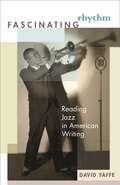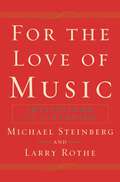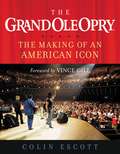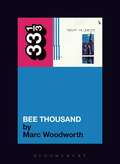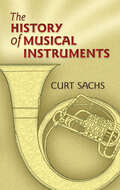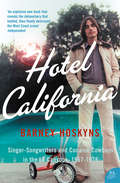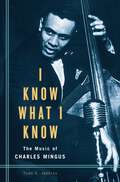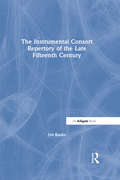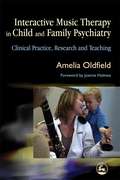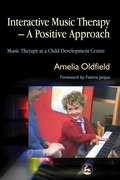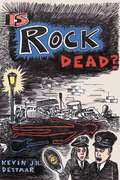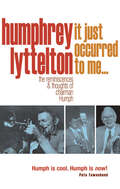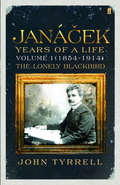- Table View
- List View
Fascinating Rhythm: Reading Jazz in American Writing
by David YaffeHow have American writers written about jazz, and how has jazz influenced American literature? In Fascinating Rhythm, David Yaffe explores the relationship and interplay between jazz and literature, looking at jazz musicians and the themes literature has garnered from them by appropriating the style, tones, and innovations of jazz, and demonstrating that the poetics of jazz has both been assimilated into, and deeply affected, the development of twentieth-century American literature. Yaffe explores how Jewish novelists such as Norman Mailer, J. D. Salinger, and Philip Roth engaged issues of racial, ethnic, and American authenticity by way of jazz; how Ralph Ellison's descriptions of Louis Armstrong led to a "neoconservative" movement in contemporary jazz; how poets such as Wallace Stevens, Hart Crane, Langston Hughes, and Frank O'Hara were variously inspired by the music; and how memoirs by Billie Holiday, Charles Mingus, and Miles Davis both reinforced and redeemed the red light origins of jazz. The book confronts the current jazz discourse and shows how poets and novelists can be placed in it--often with problematic results. Fascinating Rhythm stops to listen for the music, demonstrating how jazz continues to speak for the American writer.
For The Love of Music: Invitations to Listening
by Michael Steinberg Larry RotheThe power of music, the way it works on the mind and heart, remains an enticing mystery. Now two noted writers on classical music, Michael Steinberg and Larry Rothe, explore the allure of this melodious art--not in the clinical terms of social scientists--but through stories drawn from their own experience. In For the Love of Music, Steinberg and Rothe draw on a lifetime of listening to, living with, and writing about music, sharing the delights and revelatory encounters they have had with Mozart, Brahms, Stravinsky, and a host of other great (and almost-great) composers. At once highly personal and immediately accessible, their writings shed light on those who make music and those who listen to it--drawing readers into the beautiful and dangerous terrain that has meant so much to the authors. In recounting how they themselves came to love music, Steinberg and Rothe offer keys for listening. You will meet the man who created the sound of Hollywood's Golden Age and you will learn how composers have addressed issues as contemporary as AIDS and the terrorist attacks of September 11.
Franz Liszt and His World
by Christopher H. Gibbs Dana GooleyNo nineteenth-century composer had more diverse ties to his contemporary world than Franz Liszt (1811-1886). At various points in his life he made his home in Vienna, Paris, Weimar, Rome, and Budapest. In his roles as keyboard virtuoso, conductor, master teacher, and abbé, he reinvented the concert experience, advanced a progressive agenda for symphonic and dramatic music, rethought the possibilities of church music and the oratorio, and transmitted the foundations of modern pianism. The essays brought together in Franz Liszt and His World advance our understanding of the composer with fresh perspectives and an emphasis on historical contexts. Rainer Kleinertz examines Wagner's enthusiasm for Liszt's symphonic poem Orpheus; Christopher Gibbs discusses Liszt's pathbreaking Viennese concerts of 1838; Dana Gooley assesses Liszt against the backdrop of antivirtuosity polemics; Ryan Minor investigates two cantatas written in honor of Beethoven; Anna Celenza offers new insights about Liszt's experience of Italy; Susan Youens shows how Liszt's songs engage with the modernity of Heinrich Heine's poems; James Deaville looks at how publishers sustained Liszt's popularity; and Leon Botstein explores Liszt's role in the transformation of nineteenth-century preoccupations regarding religion, the nation, and art. Franz Liszt and His World also includes key biographical and critical documents from Liszt's lifetime, which open new windows on how Liszt was viewed by his contemporaries and how he wished to be viewed by posterity. Introductions to and commentaries on these documents are provided by Peter Bloom, José Bowen, James Deaville, Allan Keiler, Rainer Kleinertz, Ralph Locke, Rena Charnin Mueller, and Benjamin Walton.
Franz Liszt and His World
by Christopher H. Gibbs Dana GooleyNo nineteenth-century composer had more diverse ties to his contemporary world than Franz Liszt (1811-1886). At various points in his life he made his home in Vienna, Paris, Weimar, Rome, and Budapest. In his roles as keyboard virtuoso, conductor, master teacher, and abbé, he reinvented the concert experience, advanced a progressive agenda for symphonic and dramatic music, rethought the possibilities of church music and the oratorio, and transmitted the foundations of modern pianism. The essays brought together in Franz Liszt and His World advance our understanding of the composer with fresh perspectives and an emphasis on historical contexts. Rainer Kleinertz examines Wagner's enthusiasm for Liszt's symphonic poem Orpheus; Christopher Gibbs discusses Liszt's pathbreaking Viennese concerts of 1838; Dana Gooley assesses Liszt against the backdrop of antivirtuosity polemics; Ryan Minor investigates two cantatas written in honor of Beethoven; Anna Celenza offers new insights about Liszt's experience of Italy; Susan Youens shows how Liszt's songs engage with the modernity of Heinrich Heine's poems; James Deaville looks at how publishers sustained Liszt's popularity; and Leon Botstein explores Liszt's role in the transformation of nineteenth-century preoccupations regarding religion, the nation, and art. Franz Liszt and His World also includes key biographical and critical documents from Liszt's lifetime, which open new windows on how Liszt was viewed by his contemporaries and how he wished to be viewed by posterity. Introductions to and commentaries on these documents are provided by Peter Bloom, José Bowen, James Deaville, Allan Keiler, Rainer Kleinertz, Ralph Locke, Rena Charnin Mueller, and Benjamin Walton.
A Garden of Eden in Hell: The Life of Alice Herz-Sommer
by Melissa Muller Reinhard PiechockiAlice Herz-Sommer was born in 1903 in Prague, the Prague of the Hapsburgs and of Franz Kafka, a family friend. Musically very gifted, by her mid-teens Alice was one of the best-known pianists in Prague. But as the Nazis swept across Europe her comfortable, bourgeois world began to crumble around her, as anti-Jewish feeling not only intensified but was legitimised. In 1942, Alice's mother was deported. Desperately unhappy, she resolved to learn Chopin's 24 Etudes - the most technically demanding piano pieces she knew - and the complex but beautiful music saved her sanity. A year later, she, too - together with her husband and their six-year-old son - was deported to a concentration camp. But even in Theresienstadt, music was her salvation and in the course of more than a hundred concerts she gave her fellow-prisoners hope in a world of pain and death. This is her remarkable story, but it is also the story of a mother's struggle to create a happy childhood for her beloved only son in the midst of atrocity and barbarism. Of 15,000 children sent to the camp, Raphael was one of the 130 who survived. Today, Alice Herz-Sommer lives in London and she still plays the piano every day.
The Grand Ole Opry: The Making of an American Icon
by Colin EscottThis official guide chronicles the story of the birthplace of country music as told by the people who were there. Escott presents the official inside history of the home of country music, offering fans an exclusive look into the heart and soul of country music. Full color, and packed with photos from the Opry Archives covering 80 years of history.
Guided By Voices' Bee Thousand (33 1/3)
by Marc WoodworthMarc Woodworth's book covers the album's long and unorthodox period of writing, recording, sequencing, and editing. It includes interviews with members of the band, manager Pete Jamison, web-master and GBV historian Rich Turiel and Robert Griffin of Scat Records. At least sixty-five songs were recorded and considered for the album and five distinct concepts were rejected before the band hit upon the records final form. One late version, very nearly released, contained only a few of Bee Thousand's definitive songs.The rest were left out and nearly ended up in the boxes of cassette out-takes cluttering up Robert Pollard's basement. The story of Guided By Voices transformation from an occasional and revolving group of complete unknowns to indie-rock heroes is very much part of the story behind the making of Bee Thousand.In addition to providing a central account of how the record was made, Woodworth devotes a substantial chapter to the album's lyrics. Robert Pollard's lyrics are described by critics, when they're described at all, as a brand of tossed-off surrealism, as if his verbal sensibility is somehow incidental to the songs themselves. Nothing could be further from the truth. Woodworth offers a sustained discussion of Pollard's work as a writer of often sublime, beautiful, and very human lyrics. The third key section of the book covers aesthetics. Woodworth considers the great appeal of the do-it-yourself nature of Bee Thousand and reflects on the larger importance of the strain of alternative rock for which this record is a touchstone.
Gurudev's Drumming Legacy: Music, Theory and Nationalism in the Mrdang aur Tabla Vadanpaddhati of Gurudev Patwardhan (Soas Studies In Music Ser.)
by James KippenThe 1903 Mrdang aur Tabla Vadanpaddhati is a revelatory text that has never been translated or analysed. It is a manual for playing the two most important drums of North Indian (Hindustani) music, the pakhavaj (mrdang) and the tabla. Owing to its relative obscurity, it is a source that has never been discussed in the literature on Hindustani music. Its author, Gurudev Patwardhan, was Vice Principal of V.D. Paluskar's first music school in Lahore from its inception in 1901 to 1908. Professor James Kippen provides the first translation of this immensely important text and examines its startling implications for rhythmic and metric theory. It is the earliest work on Indian drumming to contain a notation sufficiently precise to allow definitive reconstruction. The compositions are of considerable musical interest, for they can be readily realized on the tabla or pakhavaj. Kippen sets the work and objectives of the original author in the context of a rich historical, social and political background. By also discussing radical differences in the second edition of 1938, published by Gurudev's nephew, the vocalist Vinayakrao Patwardhan, Kippen illuminates the process by which 'tabla theory' was being created in the early 20th century. Both Patwardhans were enthusiastic supporters of Paluskar's nationalist imperatives, and active participants in his drive to institutionalize music, codify and publish notations of it, and promote a modern, Hindu vision of India wherein its identity could once again be linked to a glorious golden age in distant antiquity.
Gurudev's Drumming Legacy: Music, Theory and Nationalism in the Mrdang aur Tabla Vadanpaddhati of Gurudev Patwardhan (Soas Studies In Music Ser.)
by James KippenThe 1903 Mrdang aur Tabla Vadanpaddhati is a revelatory text that has never been translated or analysed. It is a manual for playing the two most important drums of North Indian (Hindustani) music, the pakhavaj (mrdang) and the tabla. Owing to its relative obscurity, it is a source that has never been discussed in the literature on Hindustani music. Its author, Gurudev Patwardhan, was Vice Principal of V.D. Paluskar's first music school in Lahore from its inception in 1901 to 1908. Professor James Kippen provides the first translation of this immensely important text and examines its startling implications for rhythmic and metric theory. It is the earliest work on Indian drumming to contain a notation sufficiently precise to allow definitive reconstruction. The compositions are of considerable musical interest, for they can be readily realized on the tabla or pakhavaj. Kippen sets the work and objectives of the original author in the context of a rich historical, social and political background. By also discussing radical differences in the second edition of 1938, published by Gurudev's nephew, the vocalist Vinayakrao Patwardhan, Kippen illuminates the process by which 'tabla theory' was being created in the early 20th century. Both Patwardhans were enthusiastic supporters of Paluskar's nationalist imperatives, and active participants in his drive to institutionalize music, codify and publish notations of it, and promote a modern, Hindu vision of India wherein its identity could once again be linked to a glorious golden age in distant antiquity.
Hip Hop Culture
by Emmett G. IIIThis work is a revealing chronicle of Hip Hop culture from its beginnings three decades ago to the present, with an analysis of its influence on people and popular culture in the United States and around the world.From Grandmaster Flash and the Furious Five's "The Message," to Jay-Z, Diddy, and 50 Cent, Hip Hop Culture is the first comprehensive reference work to focus on one of the most influential cultural phenomena of our time. Scholarly and streetwise, backed by statistics, documents, and research, it recounts three decades of Hip Hop's evolution, highlighting its defining events, recordings, personalities, movements, and ideas, as well as society's response.How did an inner-city subculture, all but dismissed in the early 1980s, become the ruler of the world's airwaves and iPods? Who are the players who moved Hip Hop from the record bins to the pinnacles of entertainment, business, and fashion? Who are the founders, innovators, legends, and major players? Authoritative and authentic, Hip Hop Culture provides a wealth of information and insights for students, educators, and anyone interested in the ways pop culture reflects and shapes our lives.
The History of Musical Instruments
by Curt SachsThis first comprehensive history of musical instruments, this book ranges from prehistoric times to the 20th century. It traverses five continents and every stage of evolution, from primitive rattles and bull-roarers to the electric organ. Author Curt Sachs, one of the world's most distinguished musicologists, combines rich scholarship with personal insight in a remarkable fusion of music, anthropology, and the fine arts.Beginning with the earliest manifestations of rhythm, Sachs explores the association of sound with primitive rites of fertility, life, death, and rebirth. He traces the evolution of folk and ritual instruments to tools of entertainment and art, the rise of a professional class of singers and musicians, and the musical revolution that flowered during the Renaissance. Sachs chronicles the foundation of the modern orchestra during the baroque period and its subsequent development, concluding with the modern-day rise of electric and jazz instruments.A pleasure to read as well as a valuable resource, this classic work is enhanced with 24 plates and 167 illustrations.
Hotel California: Singer-songwriters And Cocaine Cowboys In The L. A. Canyons 1967-1976
by Barney HoskynsThe story of a remarkable time and place: Los Angeles from the dawn of the singer-songwriter era in the mid-Sixties to the peak of The Eagles’ success in the late Seventies.
I Know What I Know: The Music of Charles Mingus (Non-ser.)
by Todd S. JenkinsFrom the mid-1940s until his death in 1979, Charles Mingus created an unparalleled body of recorded work, most of which remains available in the 21st century. While there have been several volumes devoted to Mingus's colorful and tumultuous life, this is the first book in the English language to be devoted fully to his music. General jazz fans as well as musicians and music students who would like a better understanding of Mingus's complex, often difficult music, will find a complete, chronologically arranged, listener's guide to all of his legitimate recordings, from the 78s he recorded in Los Angeles and San Francisco in the mid-1940s, through the legendary albums he made for Columbia, Candid, Atlantic, and his own labels. In the process of providing these in-depth examinations, Jenkins corrects common errors and clears away old misconceptions about certain recordings. His approach will illuminate long-obscure aspects of this imposing and incredibly creative man's contributions to the art of jazz.Touching upon Mingus's many innovations as a jazzman, I Know What I Know explores his advancement of the art of bass playing; his assimilations of Ellington and Monk with ideas leaning toward free jazz; his experiments with ensemble dynamics, instrumentation, and extended form; and his working relationships with partners such as Jaki Byard, Eric Dolphy, Jimmy Knepper, and Dannie Richmond. The book provides a broad, informative overview of Mingus's work without veering into technical musical terminology. Readers without an extensive background in music will thus understand and appreciate the analyses provided, and be able to use them to enhance the experience of listening to the brilliant work of this legendary jazz great.
I'm Coming To Take You To Lunch: A fantastic tale of boys, booze and how Wham! were sold to China
by Simon Napier-BellPop manager extraordinaire Simon Napier-Bell had had enough. He'd had enough of pop groups. He'd had enough of the constant grief at home with his two ex-boyfriends bickering and bleeding him dry; and most of all he'd had enough of the music biz. But then he fell in love with a new passion - the Far East; and a dynamic new duo - George and Andrew - jointly called Wham! Soon, in an audacious attempt to have the best of both worlds, he found himself offering to arrange for Wham! to be the first ever Western pop group to play in communist China - a masterstroke of PR which, in one swift stroke, would make them one of the biggest groups in the world. What follows is an exciting, unpredictable and hilarious romp around the more curious corners of the world as Napier-Bell dives into the unknown, attempting to achieve the unachievable. We soon find ourselves in the company of a wonderful cast of petulant pop stars, shady international 'businessmen', and a hilarious confusion of spies, students and institutionalised officials and ministers as he edges ever closer to inadvertently becoming one of the first Westerners to break down the walls of communist China.
The Instrumental Consort Repertory of the Late Fifteenth Century
by Jon BanksThough individual pieces from the late fifteenth century are widely accepted as being written for instruments rather than voices, they are traditionally considered as exceptions within the context of a mainstream of vocal polyphony. After a rigorous examination of the criteria by which music of this period may be judged to be instrumental, Dr Jon Banks isolates all such pieces and establishes them as an explicit genre alongside the more commonly recognized vocal forms of the period. The distribution of these pieces in the manuscript and early printed sources of the time demonstrate how central instrumental consorts were to musical experience in Italy at this time. Banks also explores the social background to Italian music-making, and particularly the changing status of instrumentalists with respect to other musicians. Convincing evidence is put forward in particular for the lute ensemble to be a likely performance context for many of the surviving sources. The book is not intended to be a prescriptive account for the role of instruments in late medieval music, but instead restores an impressive but largely overlooked consort repertory to its rightful place in the history of music.
The Instrumental Consort Repertory of the Late Fifteenth Century
by Jon BanksThough individual pieces from the late fifteenth century are widely accepted as being written for instruments rather than voices, they are traditionally considered as exceptions within the context of a mainstream of vocal polyphony. After a rigorous examination of the criteria by which music of this period may be judged to be instrumental, Dr Jon Banks isolates all such pieces and establishes them as an explicit genre alongside the more commonly recognized vocal forms of the period. The distribution of these pieces in the manuscript and early printed sources of the time demonstrate how central instrumental consorts were to musical experience in Italy at this time. Banks also explores the social background to Italian music-making, and particularly the changing status of instrumentalists with respect to other musicians. Convincing evidence is put forward in particular for the lute ensemble to be a likely performance context for many of the surviving sources. The book is not intended to be a prescriptive account for the role of instruments in late medieval music, but instead restores an impressive but largely overlooked consort repertory to its rightful place in the history of music.
Interactive Music Therapy in Child and Family Psychiatry: Clinical Practice, Research and Teaching
by Jo Holmes Amelia Oldfield'What is truly distinctive about this book is that Oldfield introduces her doctoral research, in which she created the Music Therapy Diagnostic Assessment (MTDA) in comparison to one of the most internationally recognized standardized diagnostic tool.' - Autism Diagnostic Observation Schedule (ADOS). 'I believe that the book will be useful for music therapy students, and novice music therapist working in child and family psychiatry and related fields.' - Nordic Journal of Music Therapy 'In her indomitable, accessible and straightforward style, Amelia Oldfield continues to champion the use of music therapy with families in her most recent publication. The book is in many ways a step-by-step music therapy manual, informing us of music therapy methods and innovations and provoking new thoughtfulness for work within the child mental health setting.' - Journal of Family Therapy 'This book could be an invaluable resource for readers who are looking for evidence that music therapy can have a very positive effect on certain disorders and family dynamics. I could imagine it would bring great hope for those whose children find communication very difficult, or where families are struggling to relate emotionally. The book [also] has a lot of clinical research data, which would be extremely useful for students or clinicians needing to validate this kind of work.' - ACCord Magazine 'This practical book outlines and explains the rationale for using music therapy in child and family psychiatry. Amelia Oldfield reflects on current research methodology and describes characteristics of her own approach to therapy sessions, including how to start and end the session, how to motivate children and establish a positive musical dialogue with them, and how to include parents in the session. She also uses video analysis techniques to assess and advance the role of the therapist. Individual chapters focus on the results of the author's research investigations with specific groups such as mothers and young children, groups of adults with profound difficulties, children with autistic spectrum disorder or severe physical and mental difficulties, as well as children without clear diagnosis. Case studies and vignettes supplement these examples. The author also considers the whole process from the initial referral for therapy and using psychiatric music therapy for diagnostic assessment to how to end treatment. This book is accessible to music therapists, psychiatrists, nurses and occupational therapists working with children and families, as well as music therapy trainers, their students and academics interested in music therapy.' - British Society for Music Therapy 'Those who are specifically interested in music therapy as applied to children and families will find no better mentor than Oldfield.' - Mental Health Care Practice 'Well, this book was a pleasant surprise! I found it a remarkably uplifting read. Amelia Oldfield describes in detail how she has managed to interact through music with children (and adults) with a wide range of significant difficulties, intellectual, emotional and physical. Her music therapy is intended to help with diagnosis but she also involved parents and carers in her sessions in a way which helps them to come to terms with and deal more comfortably with their charges.' - Adoption.net This practical book outlines and explains the rationale for using music therapy in child and family psychiatry. Amelia Oldfield reflects on current research methodology and describes characteristics of her own approach to therapy sessions, including how to start and end the session, how to motivate children and establish a positive musical dialogue with them, and how to include parents in the session. She also uses video analysis techniques to assess and advance the role of the therapist. Individual chapters focus on the results of the author's research investigations with specific groups such as mothers and young children, groups of adults with profound difficulties, children with autistic spectrum disorder or severe phy...
Interactive Music Therapy in Child and Family Psychiatry: Clinical Practice, Research and Teaching (PDF)
by Amelia Oldfield Jo Holmes'What is truly distinctive about this book is that Oldfield introduces her doctoral research, in which she created the Music Therapy Diagnostic Assessment (MTDA) in comparison to one of the most internationally recognized standardized diagnostic tool.' - Autism Diagnostic Observation Schedule (ADOS). 'I believe that the book will be useful for music therapy students, and novice music therapist working in child and family psychiatry and related fields.' - Nordic Journal of Music Therapy 'In her indomitable, accessible and straightforward style, Amelia Oldfield continues to champion the use of music therapy with families in her most recent publication. The book is in many ways a step-by-step music therapy manual, informing us of music therapy methods and innovations and provoking new thoughtfulness for work within the child mental health setting.' - Journal of Family Therapy 'This book could be an invaluable resource for readers who are looking for evidence that music therapy can have a very positive effect on certain disorders and family dynamics. I could imagine it would bring great hope for those whose children find communication very difficult, or where families are struggling to relate emotionally. The book [also] has a lot of clinical research data, which would be extremely useful for students or clinicians needing to validate this kind of work.' - ACCord Magazine 'This practical book outlines and explains the rationale for using music therapy in child and family psychiatry. Amelia Oldfield reflects on current research methodology and describes characteristics of her own approach to therapy sessions, including how to start and end the session, how to motivate children and establish a positive musical dialogue with them, and how to include parents in the session. She also uses video analysis techniques to assess and advance the role of the therapist. Individual chapters focus on the results of the author's research investigations with specific groups such as mothers and young children, groups of adults with profound difficulties, children with autistic spectrum disorder or severe physical and mental difficulties, as well as children without clear diagnosis. Case studies and vignettes supplement these examples. The author also considers the whole process from the initial referral for therapy and using psychiatric music therapy for diagnostic assessment to how to end treatment. This book is accessible to music therapists, psychiatrists, nurses and occupational therapists working with children and families, as well as music therapy trainers, their students and academics interested in music therapy.' - British Society for Music Therapy 'Those who are specifically interested in music therapy as applied to children and families will find no better mentor than Oldfield.' - Mental Health Care Practice
Interactive Music Therapy - A Positive Approach: Music Therapy at a Child Development Centre
by Fatima Janjua Amelia OldfieldIn Interactive Music Therapy - A Positive Approach, Amelia Oldfield explains how her approach to music therapy sessions establishes a constructive musical dialogue with children that emphasises positive experiences - these establish trust and allow feelings to be expressed through music. Describing the general benefits of this approach, the author also details its application for specific clinical groups including children with autistic spectrum disorders, relationship difficulties or physical disabilities. Individual chapters focus specifically on child development issues and in child and brief case studies throughout the text illustrate points of particular importance. This practical book will be of use to other clinicians and teachers working with children with a variety of needs, including children on the autism spectrum and children with learning disabilities. It is also of use to music therapy trainers, their students and academics whose interests include music therapy.
Interactive Music Therapy - A Positive Approach: Music Therapy at a Child Development Centre (PDF)
by Amelia Oldfield Fatima JanjuaIn Interactive Music Therapy - A Positive Approach, Amelia Oldfield explains how her approach to music therapy sessions establishes a constructive musical dialogue with children that emphasises positive experiences - these establish trust and allow feelings to be expressed through music. Describing the general benefits of this approach, the author also details its application for specific clinical groups including children with autistic spectrum disorders, relationship difficulties or physical disabilities. Individual chapters focus specifically on child development issues and in child and brief case studies throughout the text illustrate points of particular importance. This practical book will be of use to other clinicians and teachers working with children with a variety of needs, including children on the autism spectrum and children with learning disabilities. It is also of use to music therapy trainers, their students and academics whose interests include music therapy.
Is Rock Dead?
by Kevin J.H. DettmarRock and roll's death has been forecast nearly since its birth; the country song "The Death of Rock and Roll" appeared in September 1956, showing that the music had already outraged a more conservative listening audience. Is Rock Dead? sets out to explore the varied and sometimes conflicting ways in which the death of rock has been discussed both within the discourse of popular music and American culture. If rock is dead, when did it die? Who killed it? Why do rock journalists lament its passing? Has its academic acceptance stabbed it in the back or resuscitated an otherwise lifeless corpse? Why is rock music the music that conservatives love to hate? On the other side of the coin, how have rock's biggest fans helped nail shut the coffin? Does rock feed on its own death-and-rebirth? Finally, what signs of life are there showing that rock, in fact, is surviving?Is Rock Dead? will appeal to all those who take seriously the notion that rock is a serious musical form. It will appeal to students of popular music and culture, and all those who have ever spun a 45, cranked up the radio, or strummed an air guitar.
Is Rock Dead?
by Kevin J.H. DettmarRock and roll's death has been forecast nearly since its birth; the country song "The Death of Rock and Roll" appeared in September 1956, showing that the music had already outraged a more conservative listening audience. Is Rock Dead? sets out to explore the varied and sometimes conflicting ways in which the death of rock has been discussed both within the discourse of popular music and American culture. If rock is dead, when did it die? Who killed it? Why do rock journalists lament its passing? Has its academic acceptance stabbed it in the back or resuscitated an otherwise lifeless corpse? Why is rock music the music that conservatives love to hate? On the other side of the coin, how have rock's biggest fans helped nail shut the coffin? Does rock feed on its own death-and-rebirth? Finally, what signs of life are there showing that rock, in fact, is surviving?Is Rock Dead? will appeal to all those who take seriously the notion that rock is a serious musical form. It will appeal to students of popular music and culture, and all those who have ever spun a 45, cranked up the radio, or strummed an air guitar.
It Just Occurred to Me?: The Reminiscences And Thoughts Of Chairman Humph
by Humphrey LytteltonThe legendary band leader and jazz trumpeter, broadcaster and humorist looks back at his extraordinarily rich and varied life and the many colourful characters he has known and played with – from Duke Ellington to Louis Armstrong. He also recalls his early life as the son of a famous housemaster at Eton, where he was educated.
Janacek (1854-1914): The Lonely Blackbird
by Dr John TyrrellJohn Tyrrell's biography of the Leos Janácek is the culmination of a life's work in the field. It stands upon his existing documentary studies of Janácek's operas and translations of other key sources and his examination of thousands of still unpublished letters and other documents in the Janácek archive in Brno. Altogether it provides the most detailed account of Janácek's life in any language and offers new views of Janácek as composer, writer, thinker and human being. Volume 1, which goes up to the outbreak of the First World War and Janácek's sixtieth birthday in the summer of 1914, consists of chronological chapters providing a straightforward account of Janácek's life year by year and another forty contextual chapters. Topics include on-going sequences ('Music as autobiography I', etc.; 'Janácek's knowledge of opera I', etc.) and individual chapters on Janácek as a teacher, as a theorist, as an music ethnographer, on his speech-melody theory, his relationship to particularly influential operas (Tchaikovsky's Queen of Spades, Charpentier's Louise), on his mentors (such as Antonín Dvorák) and his bêtes noires (such as Karel Kovarovic). A particular feature are the specially commissioned chapters on Janácek's health by Dr Stephen Lock (one of the editors of the Oxford Illustrated Companion to Medicine, OUP 1994 and 2001, editor of the British Medical Journal, 1975-91, and a Janácek enthusiast since the early postwar broadasts on the Third Programme), and on Janácek's earnings and finances by Dr Jirí Zahrádka (curator of the Janácek archive in Brno, and editor of authentic editions of Sárka and The Excursions of Mr Broucek).
Joni Mitchell's Court and Spark (33 1/3)
by Sean NelsonCourt and Spark is Joni Mitchell's most overt attempt at making a hit record, full of glossy production, catchy choruses, and even guest stars from every stratum of rock culture, high (Robbie Robertson) and low (Cheech and Chong). The record was a smash, reaching number two on the charts in March of 1974, spawning three hit singles; Help Me, Free Man in Parisand Raised on Robbery and cementing Mitchell's position as a commercial as well as an artistic force. Sean Nelson, a well known musician himself (Harvey Danger, the Long Winters), is particularly well equipped to understand all the elements that went into the making of this classic album, and he does so with clarity and wit.
